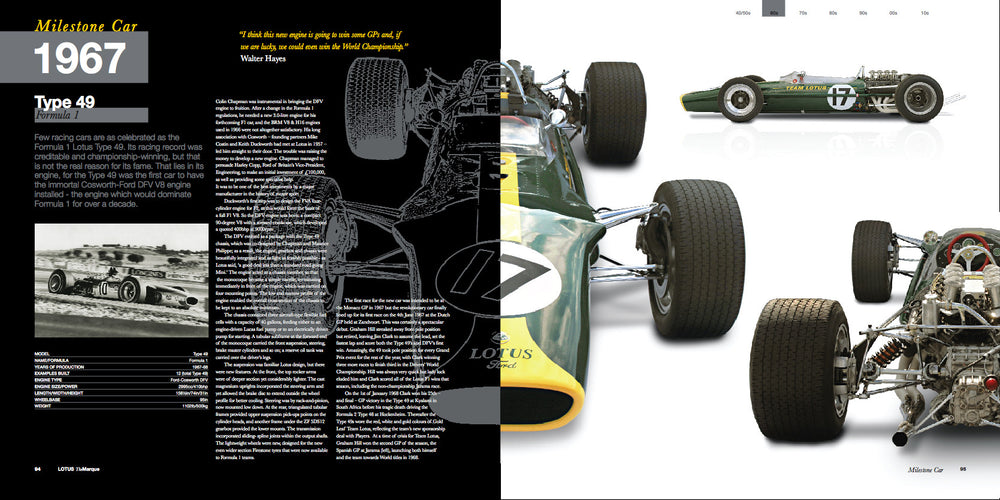Colin Chapman formed Lotus Cars in 1952, and in the ensuing decades the green and yellow Formula cars shifted the paradigms of the sport forever. While most teams placed an outsized importance on engine development, Chapman's decree to "Simplify, then add lightness," proved wildly successful, earning the relatively small company a lasting significance in motorsport. Beyond the potency on the race track, the Lotus ideology was injected into the production sports cars as well, with examples like the Seven, the Elan, the Esprit, and more commanding equal parts respect and admiration by those who understood the joys of lightweight vehicles with superb handling characteristics.
We love the Lotus story, and this pair of titles from Coterie Press offer the kind of insight and thoroughness of research that other fans of the brand will relish in like we did on our first reads. Both of these books are available in our Shop (though please note that they are available to US customers only at this time), so whether you're looking for the expansive and inclusive history of the marque as a whole, or are curious about the process of design, engineering, and management of the venerable Esprit model line, these two titles have you covered.

Lotus: The Marque
Author: William Taylor Publisher: Coterie Press Format: Hardcover, 312 pages View
William Taylor took the photographs for, and wrote his first book (The Lotus Book) in 1998. This title quickly became known as "The Yellow Book" and is commonly regarded the 'Lotus Bible’. Revised in 1999, and then again in 2004, the Yellow Book has been out of print, but in demand for several years now, and, with so many new cars emerging from Hethel since 2004, William felt it was time for a long overdue update.

But, this is no ordinary update of the earlier book, it is a completely new and redesigned book that follows the concept of the previous one (of course featuring every Lotus Type), but improves on the breed. If you thought William’s earlier book was good, this 312-page, large-format, 12x12-inch book features 208 cars and contains over 500 superb photographs, and truely is: The Ultimate book on all the Lotus Cars.




Working closely with Lotus Cars, a totally new book has been constructed. One that agains feature every Type Number and model of car produced by Lotus, from the Mark 1 in 1948, through to the 2013 Elise S Club Racer. Organised in an easy to read format, but now in chronological order rather than Type Number order, the book charts the development of the marque from 1948 to 2014. Coterie Press have worked with Lotus Cars, and the Lotus Cars Design Department, to completely re-design the layout of the book, one that offers a stylish and yet comprehensive, in depth look at every model of Lotus, decade by decade.

Lotus Esprit: The Official Story
Author: Jeremy Walton Publisher: Coterie Press Format: Hardcover, 224 pages View
Lotus Esprit: The Official Story is the inside story of Britain’s best loved supercar from it’s development in the early 1970s right through to the 21st century. This large format 224-page hard back book contains over 550 photographs taken from the archives of Lotus Cars and Coterie Images, and is a must for any Esprit enthusiast.That the Esprit ever appeared in the showroom, never mind set a record for British sportscar continuous production from 1976-2004, is a story straight from the Lotus era. How Colin Chapman labored alongside Italian designer and fellow genius Giorgetto "Giorgio" Giugiaro, to bring the first show Esprit to life, is just one of the stories unveiled by Jeremy Walton’s research.


The Esprit, in all its Lotus Type numbers, and derivatives, from the very first Type 79 (the Esprit Type number—not to be confused with the Lotus Formula One cars which carries the same Type Number!) onwards, is revealed in this seriously comprehensive book. A total of under 11,000 Esprits were made in its 28 year production span, which means that some models had production numbers of less than 100. Supremely agile and rapid Esprits, such as the Sport 300 and V8 350, are examined in all their 160 to 175 mph glories—along with the race track inspired Esprit Turbo SCCA, X180R, and Type 114 Esprit GT1.


As with Walton’s acclaimed Lotus Elise title for Coterie, this conscientious Esprit production was enabled only by the full co-operation of Lotus Cars, and once again they gave frank access to their archives as well as their employees.Lotus Esprit: The Official Story contains the reminiscences of the loyalists, and the youngsters, who added to their growing reputations when involved in the concept and design of the Esprit, many who are now famous industry figures following a Lotus apprenticeship. The author’s trusted participation at every stage in the Esprit’s long life is reflected by the openness of all involved. They tell us the real stories behind the car, leaving us with hope of an innovative new Esprit before too long.




















































